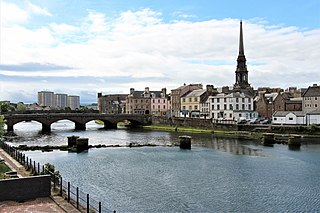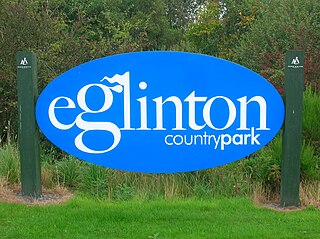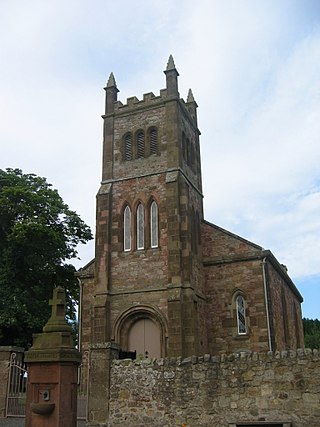
South Ayrshire is one of thirty-two council areas of Scotland, covering the southern part of Ayrshire. It borders onto Dumfries and Galloway, East Ayrshire and North Ayrshire. South Ayrshire had an estimated population in 2021 of 112,450, making it the 19th–largest subdivision in Scotland by population. With an area of 472 sq mi, South Ayrshire ranks as the 15th largest subdivision in Scotland.

Ayr is a town situated on the southwest coast of Scotland. A former royal burgh, today it is the administrative centre of South Ayrshire Council, and the historic county town of Ayrshire. With a population of 46,982, Ayr is the 15th largest settlement in Scotland and second largest town in Ayrshire by population. The town is contiguous with the smaller town of Prestwick to the north. Ayr submitted unsuccessful bids for city status in 2000 and 2002, and as part of the wider South Ayrshire area in 2022.

Alloway is a suburb of Ayr, and former village, in South Ayrshire, Scotland, located on the River Doon. It is best known as the birthplace of Robert Burns and the setting for his poem "Tam o' Shanter". Tobias Bachope, the mason responsible for the construction of Hopetoun House, Craigiehall, and Kinross House, also hailed from Alloway. Some historic parts of the village make up a conservation area.

Thomas Hamilton was a Scottish architect, based in Edinburgh where he designed many of that city's prominent buildings. Born in Glasgow, his works include: the Burns Monument in Alloway; the Royal High School on the south side of Calton Hill ; the Royal College of Physicians of Edinburgh; the George IV Bridge, which spans the Cowgate; the Dean Orphan Hospital, now the Dean Gallery; the New North Road Free Church, now the Bedlam Theatre; Cumstoun, a private house in Dumfries and Galloway; and the Scottish Political Martyrs' Monument in Old Calton Cemetery, Edinburgh.

Stair is a parish in Ayrshire, Scotland. It lies at the bottom of a glen beside the River Ayr at the north-west border of the 5,376 acre (22 km2) Parish of Stair where the River Ayr is joined by the Glenstang Burn.
The Burns Club of Atlanta, officially organized in 1896, is a private social club and literary and cultural society commemorating the works and spirit of the 18th century national poet of Scotland, Robert Burns. In addition to holding monthly meetings, the club has held a Burns supper celebration on the anniversary of Burns' birthday every year since 1898. Club events are held in the Atlanta Burns Cottage, a 1911 replica of poet Robert Burns' birthplace in Alloway, Ayrshire, Scotland. The Cottage has been listed on the National Register of Historic Places as Burns Cottage since 1983.

The River Doon is a river in Ayrshire, Scotland. Its course is generally north-westerly, passing near to the town of Dalmellington, and through the villages of Patna, Dalrymple, and Alloway, birthplace of Robert Burns. The source of the Doon is Loch Doon, high in the Galloway Hills.

"Tam o' Shanter" is a narrative poem written by the Scottish poet Robert Burns in 1790, while living in Dumfries. First published in 1791, at 228 lines it is one of Burns' longer poems, and employs a mixture of Scots and English.

Agnes Broun, Agnes Brown or Agnes Burnes, was the mother of Scotland's national poet, Robert Burns. Agnes's father, Gilbert (1708–1774), was the tenant of the 300-acre (120 ha) farm of Craigenton, in Kirkoswald parish, South Ayrshire, Scotland.

Eglinton Country Park is located on the grounds of the old Eglinton Castle estate in Kilwinning, North Ayrshire, Scotland. Eglinton Park is situated in the parish of Kilwinning, part of the former district of Cunninghame, and covers an area of 400 ha ([98 acres ] of which are woodland. The central iconic feature of the country park is the ruined Eglinton Castle, once home to the Eglinton family and later the Montgomeries, Earls of Eglinton and chiefs of the Clan Montgomery. Eglinton Country Park is managed and maintained by North Ayrshire Council and its Ranger Service.
Riccarton is a village and parish in East Ayrshire, Scotland. It lies across the River Irvine from Kilmarnock, this river forming the boundary between Riccarton and Kilmarnock parishes, and also between the historical districts of Kyle and Cunningham. The name is a corruption of 'Richard's town', traditionally said to refer to Richard Wallace, the uncle of Sir William Wallace. The parish also contains the village of Hurlford.
Fergushill is a small community in North Ayrshire, Parish of Kilwinning, Scotland. The Barony of Fergushill was held by the Fergushill family of that Ilk and the area has a complex history.

Robert Burns, also known familiarly as Rabbie Burns, was a Scottish poet and lyricist. He is widely regarded as the national poet of Scotland and is celebrated worldwide. He is the best known of the poets who have written in the Scots language, although much of his writing is in a "light Scots dialect" of English, accessible to an audience beyond Scotland. He also wrote in standard English, and in these writings his political or civil commentary is often at its bluntest.

The Robert Burns Birthplace Museum is a museum which houses collections relating to the life of Robert Burns, Scotland's national Bard. It is run by the National Trust for Scotland (NTS) and is located within Alloway in Ayrshire, the village where Burns was born. It neighbours Burn's Cottage, the house in which Burns was born.

Burns Clubs exist throughout the world to encourage and cherish the memory of Robert Burns, to foster a love of his writings and generally to encourage an interest in the Scots Language and Literature. An emphasis on encouraging the young to take an interest in Burns is found in most clubs through poetry, singing and other competitions. Once mainly existing as 'male only' clubs in the mould of the Tarbolton 'Batchelor's Club' most now welcome women as fellow members. Ladies Burns Clubs also exist such as the 'Irvine Lasses' that was established in 1975; it has appointed several male 'Honorary Lasses'.

Agnes Burns or Agnes Galt was the eldest sister of Scottish poet and lyricist Robert Burns. She was born in 1762 at the Alloway Cottage in South Ayrshire to William Burnes and Agnes Broun. She did not adopt the spelling 'Burnes'. At the advanced age of forty-two, late for the times in which she lived, she married William Galt at Dinning in 1804 who had worked for her brother Gilbert at Dinning Farm in Nithsdale.

John Richmond (1765–1846) was one of Robert Burns's closest friends and confidants. He was born in Sorn parish at Montgarswood, Ayrshire, Scotland. His father, Henry Richmond, was a merchant in Mauchline and owned Montgarswood Farm that lies near Sorn. This farm passed to James, John's brother, having once been farmed by William Fisher, Burns's Holy Willie.

John Murdoch of Ayr was Robert Burns's most significant teacher or tutor and he was a friend of the Burnes family. He was born in 1747 and first taught Gilbert and Robert Burns in Alloway when he was only aged eighteen. He remained in contact with the Burnes family for several years after leaving Ayrshire for London. Murdoch, William Burnes and Richard Brown were amongst the most significant influences on Burns life during his early years in Ayrshire.

John Ballantine (1743–1812), was a Scottish merchant and banker and one of the greatest friends, admirers and closest confidants of Robert Burns. Significantly Ballantine gave the poet advice on the selection of poems for his First Kilmarnock Edition as well as being asked for his opinion on the bard's poems.

Annabella Burns or Nannie Burns (1764–1832) was the second oldest sister of the poet Robert Burns, and the last child born to William Burness and Agnes Broun whilst at the Alloway cottage. She was born on the 14 November 1764 and she was christened on 17 November by Rev. William Dalrymple, the minister of Ayr Parish Church. When she died in 1832 she was the last member of Gilbert Burns's household at Grant's Brae to be buried at the Bolton Kirk family lair. Gilbert Burns had died, also aged 67, five years earlier in 1827.




























